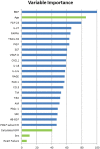Data-driven discovery and validation of circulating blood-based biomarkers associated with prevalent atrial fibrillation
- PMID: 30615112
- PMCID: PMC6475521
- DOI: 10.1093/eurheartj/ehy815
Data-driven discovery and validation of circulating blood-based biomarkers associated with prevalent atrial fibrillation
Abstract
Aims: Undetected atrial fibrillation (AF) is a major health concern. Blood biomarkers associated with AF could simplify patient selection for screening and further inform ongoing research towards stratified prevention and treatment of AF.
Methods and results: Forty common cardiovascular biomarkers were quantified in 638 consecutive patients referred to hospital [mean ± standard deviation age 70 ± 12 years, 398 (62%) male, 294 (46%) with AF] with known AF or ≥2 CHA2DS2-VASc risk factors. Paroxysmal or silent AF was ruled out by 7-day ECG monitoring. Logistic regression with forward selection and machine learning algorithms were used to determine clinical risk factors, imaging parameters, and biomarkers associated with AF. Atrial fibrillation was significantly associated with age [bootstrapped odds ratio (OR) per year = 1.060, 95% confidence interval (1.04-1.10); P = 0.001], male sex [OR = 2.022 (1.28-3.56); P = 0.008], body mass index [BMI, OR per unit = 1.060 (1.02-1.12); P = 0.003], elevated brain natriuretic peptide [BNP, OR per fold change = 1.293 (1.11-1.63); P = 0.002], elevated fibroblast growth factor-23 [FGF-23, OR = 1.667 (1.36-2.34); P = 0.001], and reduced TNF-related apoptosis-induced ligand-receptor 2 [TRAIL-R2, OR = 0.242 (0.14-0.32); P = 0.001], but not other biomarkers. Biomarkers improved the prediction of AF compared with clinical risk factors alone (net reclassification improvement = 0.178; P < 0.001). Both logistic regression and machine learning predicted AF well during validation [area under the receiver-operator curve = 0.684 (0.62-0.75) and 0.697 (0.63-0.76), respectively].
Conclusion: Three simple clinical risk factors (age, sex, and BMI) and two biomarkers (elevated BNP and elevated FGF-23) identify patients with AF. Further research is warranted to elucidate FGF-23 dependent mechanisms of AF.
Keywords: Atrial fibrillation; BNP; Biomarkers; FGF-23; Machine learning; Validation.
© The Author(s) 2019. Published by Oxford University Press on behalf of the European Society of Cardiology.
Figures







Comment in
-
Body composition and atrial fibrillation: a Mendelian randomization study.Eur Heart J. 2019 Apr 21;40(16):1277-1282. doi: 10.1093/eurheartj/ehz003. Eur Heart J. 2019. PMID: 30721963 Free PMC article.
References
-
- Wachter R, Gröschel K, Gelbrich G, Hamann GF, Kermer P, Liman J, Seegers J, Wasser K, Schulte A, Jürries F, Messerschmid A, Behnke N, Gröschel S, Uphaus T, Grings A, Ibis T, Klimpe S, Wagner-Heck M, Arnold M, Protsenko E, Heuschmann PU, Conen D, Weber-Krüger M.. Holter-electrocardiogram-monitoring in patients with acute ischaemic stroke (Find-AFRANDOMISED): an open-label randomised controlled trial. Lancet Neurol 2017;16:282–290. - PubMed
-
- Grond M, Jauss M, Hamann G, Stark E, Veltkamp R, Nabavi D, Horn M, Weimar C, Kohrmann M, Wachter R, Rosin L, Kirchhof P.. Improved detection of silent atrial fibrillation using 72-hour Holter ECG in patients with ischemic stroke: a prospective multicenter cohort study. Stroke 2013;44:3357–3364. - PubMed
-
- Kirchhof P, Benussi S, Kotecha D, Ahlsson A, Atar D, Casadei B, Castella M, Diener HC, Heidbuchel H, Hendriks J, Hindricks G, Manolis AS, Oldgren J, Popescu BA, Schotten U, Van Putte B, Vardas P, Agewall S, Camm J, Baron EG, Budts W, Carerj S, Casselman F, Coca A, De Caterina R, Deftereos S, Dobrev D, Ferro JM, Filippatos G, Fitzsimons D, Gorenek B, Guenoun M, Hohnloser SH, Kolh P, Lip GY, Manolis A, McMurray J, Ponikowski P, Rosenhek R, Ruschitzka F, Savelieva I, Sharma S, Suwalski P, Tamargo JL, Taylor CJ, Van Gelder IC, Voors AA, Windecker S, Zamorano JL, Zeppenfeld K.. 2016 ESC guidelines for the management of atrial fibrillation developed in collaboration with EACTS. Eur Heart J 2016;37:2893–2962. - PubMed
-
- Boriani G, Laroche C, Diemberger I, Fantecchi E, Popescu MI, Rasmussen LH, Sinagra G, Petrescu L, Tavazzi L, Maggioni AP, Lip GYH.. Asymptomatic atrial fibrillation: clinical correlates, management, and outcomes in the EORP-AF pilot general registry. Am J Med 2015;128:509–518.e2. - PubMed
Publication types
MeSH terms
Substances
Grants and funding
LinkOut - more resources
Full Text Sources
Other Literature Sources
Medical

